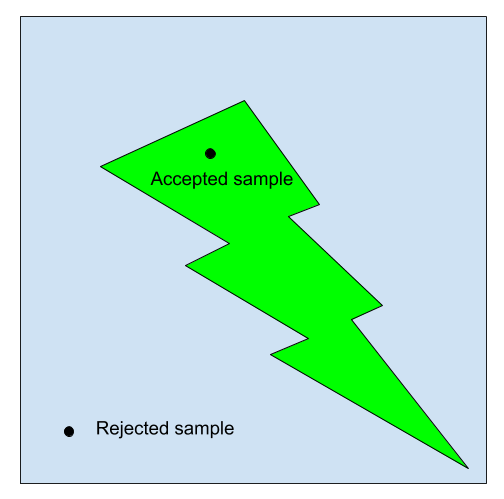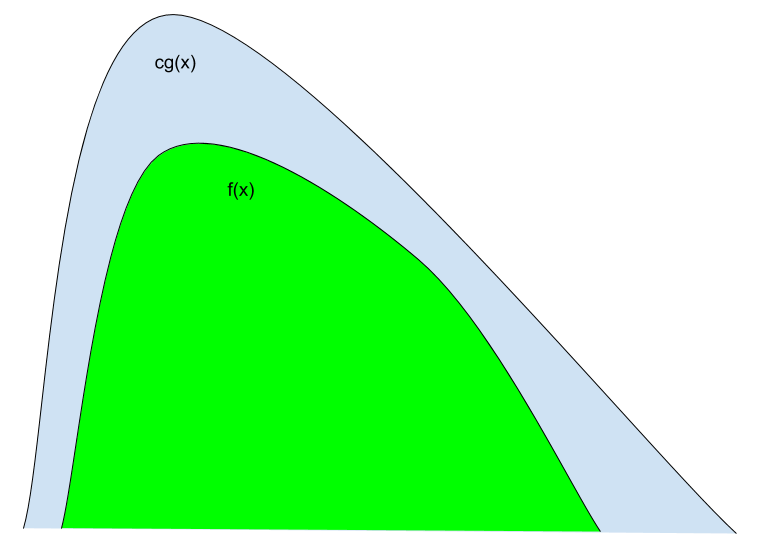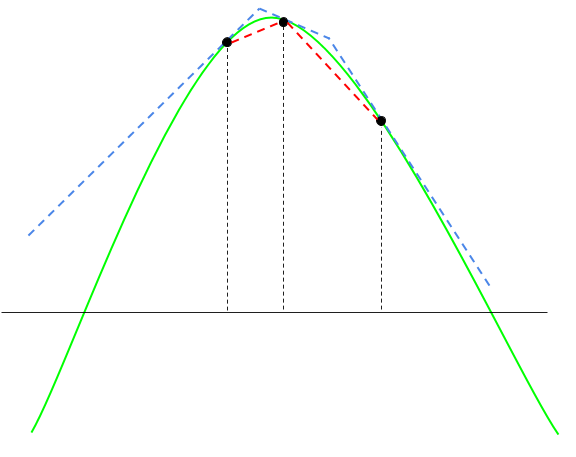statsandstuff a blog on statistics and machine learning
Sampling from distributions

There is almost no difference between knowing a distribution’s density (and thus knowing its mean, variance, mode, or anything else about it) and being able to sample from the distribution. On the one hand, if we can sample from a distribution, we can estimate the density with a histogram or kernel density estimator. Conversely, I’ll discuss ways to sample from a density in this post.
I said “almost no difference” because to sample from a density, you do need some external source of randomness. Sampling techniques do not create randomness, but rather transform one kind of random samples (usually uniform) into samples from a specified density. As an aside, a uniform random sample \(x\) can be generated by flipping a coin infinitely many times. First flip a coin to decide whether to look for \(x\) in the first or second half of the interval \((0,1)\). If the coin shows heads, we look for \(x\) in \([0,0.5)\), otherwise we look in \([0.5,1)\). This process is repeated recursively. For example, if the first toss is heads, we toss again to decide whether to look for \(x\) in \([0,0.25)\) or \([0.25,0.5)\). In practice, to sample \(x\) with 9 digits of accuracy, we only need to toss the coin 30 times.
The observation that we can estimate anything about a distribution by being able to draw samples from it is important for Bayesian statistics in practice. Bayesian inference is a matter of being able to draw from the posterior. I’ll now touch on various methods for generating random samples from a given density.
Use related distributions
There are many relationships between common random variables. For example,
- If \(Z\) is standard normal, then \(\sigma Z + \mu\) is \(N(\mu, \sigma^2)\).
- If \(Z\) is standard normal and \(V\) is independently \(\chi^2_{p}\), then \(T = \frac{Z}{\sqrt{V / p}}\) has Student’s t-distribution with \(p\) degrees of freedom.
- If \(U\) is uniform, then \(-\frac{1}{\beta} \log(U)\) is exponential with rate \(\beta\).
- If \(X \sim \text{Gamma}(\alpha, \lambda)\) and independently \(Y \sim \text{Gamma}(\beta, \lambda)\), then \(\frac{X}{X+Y} \sim \text{Beta}(\alpha, \beta)\).
These relationships can be exploited to generate random samples. For example, to draw \(x\) from an exponential distribution with rate parameter 1, first draw \(u\) uniformly over \((0,1)\) and set \(x = -\log(u)\). Along the same line, a \(\text{Beta}(\alpha, \beta)\) random draw can be formed as the ratio of two exponential draws (exponential is a special case of gamma):
\[\frac{\frac{1}{\alpha}\log(u_1)}{\frac{1}{\alpha}\log(u_1) + \frac{1}{\beta}\log(u_2)}\]Inverse CDF method
If \(F\) is an invertible CDF and \(U\) is uniform, then \(X = F^{-1}(U)\) is distributed with CDF \(F\):
\[\begin{aligned} \textbf{P}(X \leq t) &= \textbf{P}(F^{-1}(U) \leq t) \\ &=\textbf{P}(U \leq F(t)) \\ &= F(t) \end{aligned}\]Summary: if we know the inverse CDF of a distribution, we can sample from it. As an aside, the inverse CDF of an exponential distribution is \(F^{-1}(t) = -\frac{1}{\beta} \log(t)\), which we used in the previous section.
We can approximate the inverse CDF method with a Riemann sum. Below I approximate a density with rectangles.

The CDF is represented by stacking these rectangles end to end to form a strip. The inverse is represented in the color-coding. In the figure, a dot is drawn uniformly on the strip, and is mapped back (using colors) to get a sample from the density.
Rejection sampling
Rejection sampling is a technique to sample from a subset, assuming we know how to sample from the larger set. I’ll explain the technique with an example. Suppose I want to sample a random point from a lightning bolt subset of a square.

In rejection sampling, I first draw a point uniformly at random from the square, and I accept the sample if it lands in the lightning bolt, and reject the sample otherwise. The accepted samples are distributed uniformly over the lightning bolt.The probability that a sample is accepted is the area of the lightning bolt over the area of the square. The acceptance probability measures the efficiency of the method: if I want \(n\) random samples from the lightning bolt, on average I have to draw \(\frac{n}{\textbf{P}(\text{acceptance})}\) samples from the square.
Rejection sampling is often introduced as a technique for drawing from a density. Drawing from a density is equivalent to drawing uniformly from the region below the density. To be more precise, drawing a random variable from a density \(f\) is equivalent to drawing uniformly from the region below the density in the following sense:
- If \((x,y)\) is drawn uniformly over the region below the density, then \(x\) is a random draw from \(f\).
- If \(x\) is a random draw from \(f\), and \(y\) is a uniform draw from the interval \((0, f(x))\), then \((x, y)\) is uniformly distributed over the region below the density.
To sample from \(f\) with rejection sampling, we first find a proposal density \(g\) and constant \(c \geq 1\) with \(cg \geq f\). We then
- Sample from \(g\) to construct a uniform sample under \(c g\).
- Apply rejection sampling to get a uniform sample under \(f\).
- The x-coordinate of the uniform sample under \(f\) is a sample from \(f\).

The acceptance rate is \(1/c\), the area under \(f\) over the area under \(cg\). The more \(g\) is like \(f\), the more efficient the rejection sampling algorithm.
Constructing a proposal density \(g\) that is 1) easy to sample from and 2) closely resembles \(f\) can be challenging. Let’s walk through an example with the standard normal density \(f(x) = \frac{1}{\sqrt{2\pi}} e^{-x^2/2}\). Since \(f\) is log-concave, we can construct a piecewise exponential curve \(g\) that upper bounds (and well approximates) \(f\). This piecewise exponential curve can be sampled from quickly using the inverse CDF method.
Adaptive rejection sampling
Adaptive rejection sampling is a variant of rejection sampling that learns the proposal density \(g\) as it runs. The method applies to log-concave densities and constructs a piecewise exponential \(g\) by constructing a piecewise linear function that approximates (and upper bounds) \(h(x) = \log f(x)\).

Issues in high dimensions
Rejection sampling is generally inefficient in high dimensions. To explain, suppose I sample from standard normal by using a normal with variance \(\sigma^2 \geq 1\) as the proposal density. (This example is just to illustrate a point. We can get a standard normal sample from any other normal sample by “standardizing,” and do not need to use rejection sampling.) The standard normal has density \(f(x) = \frac{1}{\sqrt{2\pi}} e^{-x^2/2}\) and the proposal density is \(g(x) = \frac{1}{\sqrt{2\pi} \sigma} e^{-x^2/(2\sigma^2)}\). Suppose \(\sigma = 1.001\). In this case, we can set \(c = \sigma\) so that \(cg \geq f\) and the acceptance probability is \(1 / c \approx 99.9\%\). Now let \(f\) be the density of a 5000-dimensional normal random vector with covariance matrix \(I\) and suppose \(g\) has covariance matrix \(\sigma^2I\). In this case \(c = \sigma^{5000}\) and the acceptance rate \(1 / c\) is less than a percent.
In high dimensional problems that arise in Bayesian sampling, methods based off Markov chains such as MCMC or Gibbs sampling are used.
References
- Adaptive Rejection Sampling for Gibbs Sampling by W. R. Gilks and P. Wild